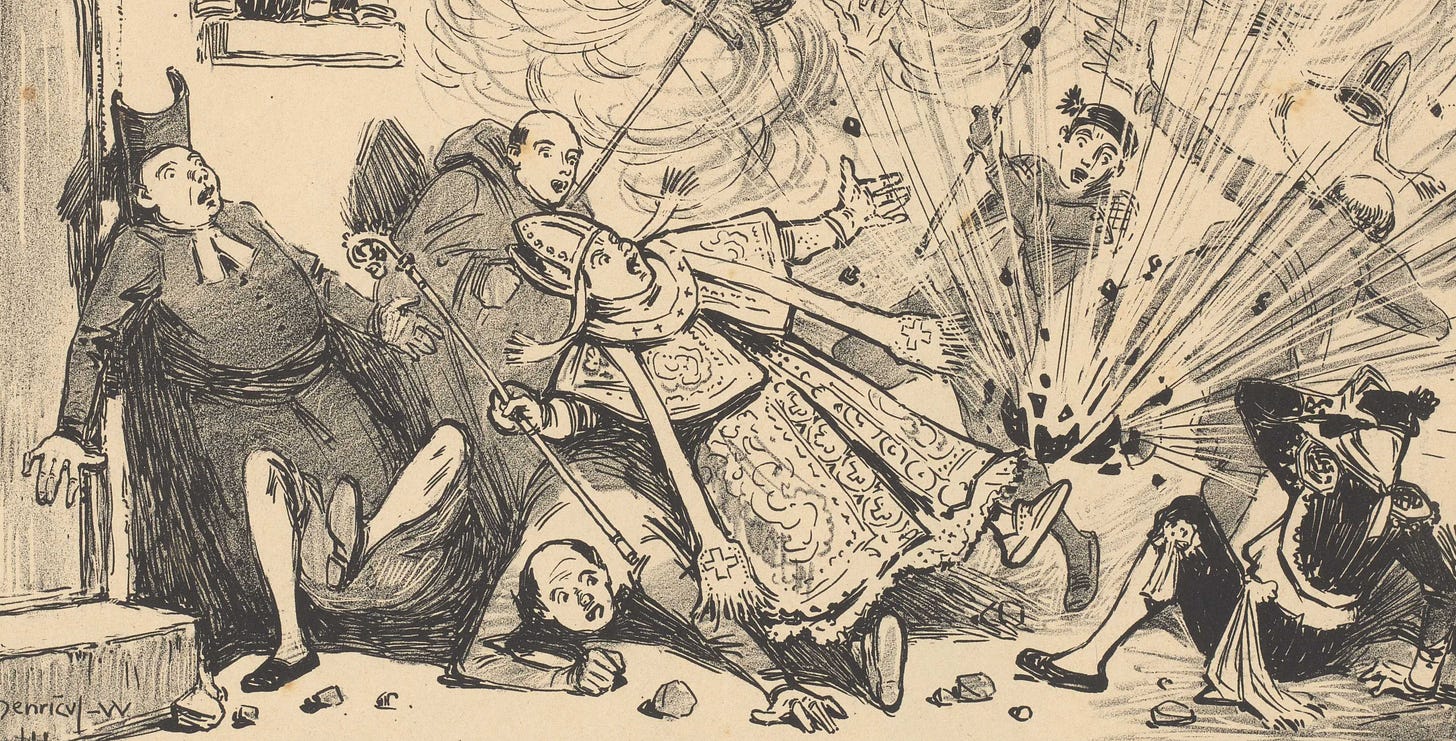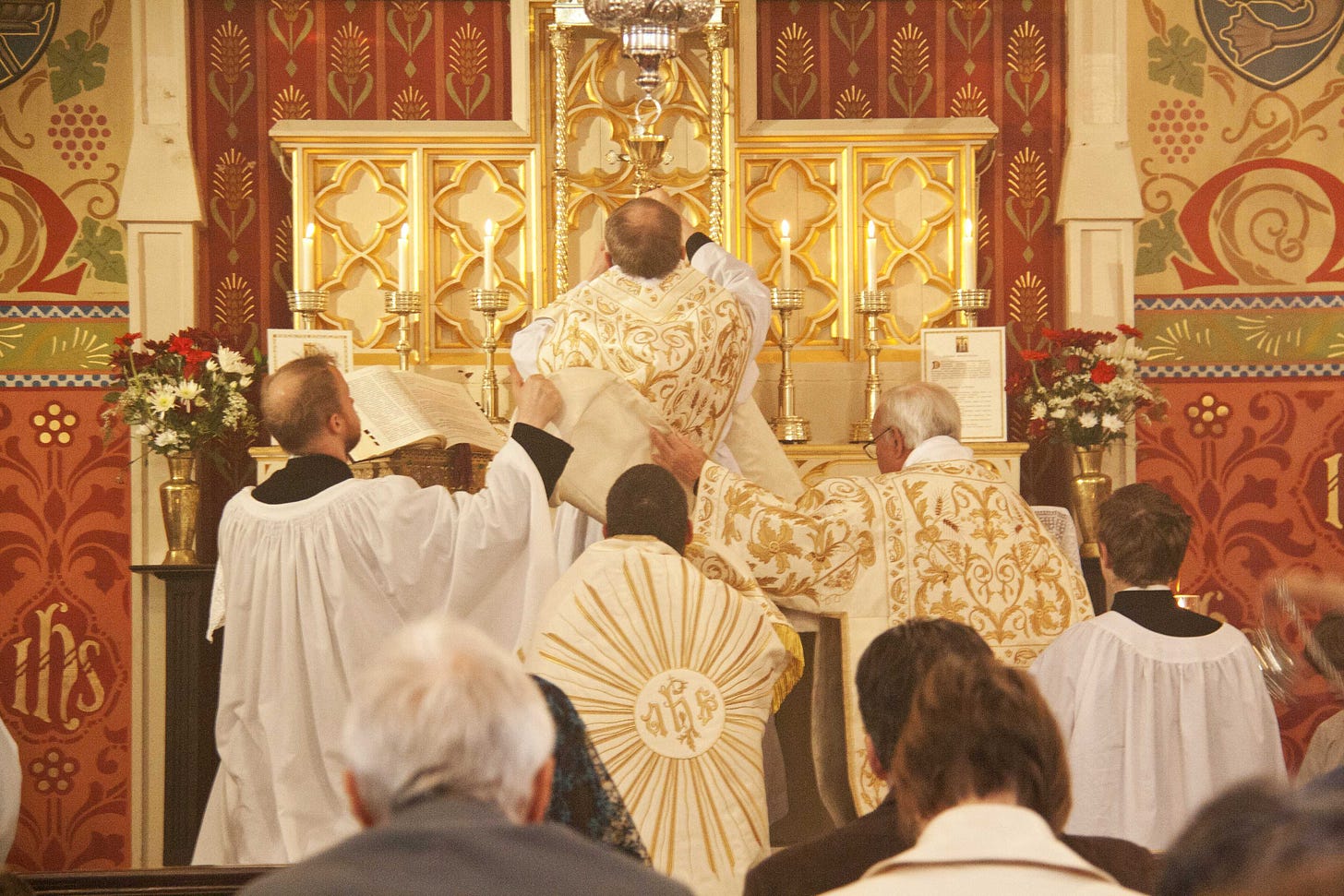Why Are Some Churchmen So Opposed to the Return of the Latin Mass?
An analysis, in two parts, on the occasion of the twelfth anniversary of Francis’s pontificate
The recent news that the Chartres pilgrims will indeed be able to hold a traditional Mass in the cathedral at the end of their pilgrimage was received with joy around the world. But it reminds us that there was a period of many months when it looked like the local bishop’s arm would be twisted by a Vatican bent on denying permission for it (as if permission could ever be needed for the venerable Roman Rite!).
This local French victory merely highlights the much larger war that has been raging in the Church since at least 1964 when the committee for creating a new liturgy was brought into being, and especially since the release of Traditionis Custodes in 2021 — namely, the war between scattered but plucky adherents of Catholic tradition and the Establishment proponents of a “renewed” Catholicism that has lurched from disaster to disaster as it bleeds members at record rates across the world. The question may well be asked: What is the pope’s or any given bishop’s or any given priest’s “beef” with the Latin Mass? Why can’t they leave law-abiding, God-fearing, tradition-loving Catholics alone?
Ah, but you see, the whole “problem” is that they are law-abiding, God-fearing, and tradition-loving. Pope Francis in particular is an antinomian, that is, someone who thinks law and custom are generally bad (unless, paradoxically, he can fashion laws or promote customs that favor his antinomian agenda); he confuses the Gospel with liberation from laws, precepts, rules, regulations, all of which are “rigid” — a very naughty quality in his worldview. Over the last twelve years, Francis has given no evidence of fearing God in his many attacks on the faithful and on Catholic doctrine, morals, and worship, as he sows confusion and scandal all over the world. And he certainly has no love for tradition; he routinely mocks those who value it, calling them “backwardists,” that is, people who supposedly want to go back in time — back before the Council. Of course, the accusation is groundless and downright silly. Most of those who attend the old Mass are much too young to remember anything about Vatican II, let alone the era before it; they simply love what is beautiful, majestic, otherworldly, and palpably religious. Not for them a humanitarian, utopian, liberation theology Catholicism blended with the agenda of the United Nations!
Did our bad behavior call down wrath upon us?
Contrary to the standard narrative in the mainstream media, the Vatican’s moves against Latin Mass Catholics are not caused by the “bad behavior” of traditionalists. The members of the Society of St. Pius X have been saying and doing all the same things for decades, and Rome always more or less let them alone or tried to work with them. Each pope in turn has met with the SSPX’s superior general for private conversation. Decades ago, well-known traditionalist writers like Michael Davies were addressing the same topics and in much the same way as can be seen today on the internet.
Joseph Ratzinger was friendly with Davies and other members of the International Una Voce Federation, welcoming them warmly in Rome and treating them kindly in all that concerned their objectives.1 Of all people in the Vatican, Cardinal Ratzinger would have been most aware of the growing worldwide desire for the TLM. That is why, as Pope Benedict XVI, he greatly broadened its use in 2007 with his apostolic letter Summorum Pontificum. Benedict didn’t think it would remain an obscure interest of a statistically marginal population; on the contrary, he already recognized, in his words, that “in the meantime [since Vatican II] it has clearly been demonstrated that young persons too have discovered this liturgical form, felt its attraction, and found in it a form of encounter with the Mystery of the Most Holy Eucharist, particularly suited to them” (Con Grande Fiducia). He knew the TLM was poised for rapid growth, and, in retrospect, he was right. At a time when Catholicism in the Western world was declining by every metric, traditional communities were growing by leaps and bounds. All this is well documented.
What has changed, then, is not the attitude or the views of traditionalists, but rather, the hostility toward traditional expressions of Catholicism in the man who occupies the chair of St. Peter. The reason for Francis’s opposition is nothing other than the continued growth of religious communities newly rooted in tradition, younger diocesan clergy who are drawn to the TLM, ex-Ecclesia Dei communities running out of room in their seminaries, populous congregations wherever tradition has a foothold. He opposes these trends for the same reasons he opposes anything and everything traditional or even conservative. He made fun of the spiritual bouquet offered to him early in his papacy. He unflatteringly connected large families with the breeding habits of rabbits. He refused to meet the original dubia cardinals (although Fr. James Martin’s dubia about the LGBTQ+ community were answered in 24 hours). He never misses an occasion to hammer on the supposed psychological disorder of “rigidity.” He wrung his hands about sexual abuse while promoting and protecting abusers. He shed crocodile tears about liturgical abuse as he engaged in it himself, and on and on.
A basic knowledge of human psychological types and of Bergoglio’s ecclesiastical career would indicate that he was going to tighten the noose at some point. He is a Peronist dictator who lives by the motto: “for the friend, everything; for the enemy, not even justice.” Even if every traditional Catholic behaved like a 1950s girl scout, he would still have it out for them; indeed, especially if they behave like 1950s girl scouts. For his war is against the “preconciliar Church” and in favor of the ultimate and lasting hegemony of “the spirit of the Council,” that is, the revolutionary interpretation of Vatican II that elevates it into a superdogma separate from and substituted for the theology and practice of all preceding centuries and generations. The traditional movement, as small as it is, is a reminder that the revolution has not been completely successful, the reprogramming has not reached everyone; indeed, to the perplexity and irritation of the revolutionary forces, the divine blessings of fruitfulness — spiritual, sacramental, and domestic — have unmistakably followed this “restorationist” constituency.

But doesn’t he have bigger fish to fry?
One often finds people expressing shock that the pope is picking on a tiny minority. Here’s an eloquent example of that puzzlement, seen on Facebook:
Have you noticed how often, in the last couple of years, the pope’s off-the-cuff comments have focused on traditionalists? There are 50 grave problems in the Church that need major papal attention, and THIS is what smolders on his mind constantly? PF’s priorities are clear in this: to heck with all those other problems. It’s the 1% traddies who need to be “dealt with,” not the 99% of dreadful Masses, the 99% of heretical “catholic” colleges, the 99% of degenerate bishops, etc. Even if traddies were wrong in loving Tradition, his inattention to the vastly larger problems is mind-boggling.
I disagree. This obsessive and seemingly disproportionate campaign against the traditionalists is perfectly logical. Pope Francis realizes that the only effective resistance to the modernist remake of Catholic doctrine, morals, and liturgy is coming from a zealous minority growing in numbers and influence. After all, it is always creative minorities that change the course of history, not the majority who float along with the spirit of the age. Every reform movement, indeed every revolution for good or for ill, has begun with an individual or a handful of people.
What is at stake is not merely “liturgical preference” but the dogmatic structure of Catholicism, the historical-theological continuity of the Church, and the soundness of Christian morality. Pope Francis’s tactical hits in all of these areas show that the ultimate aim is completing the transformation of the Catholic religion into something quite other than it has been. That is why our opposition to his entire agenda, which has Traditionis Custodes as its poster-child and the Synod as its rubber-stamping mechanism, must be inflexible, determined, and indefatigable, and why obedience must be tendered only to what is true and good, not to what is false and wicked.
Often one hears conservative Catholics saying: “Why do you spend so much time diagnosing problems, errors, failings, abuses? Should we not focus our attention on what is good?” Of course we should be focusing on what is good: that, indeed, is why traditional Catholics pray with the ancient rites, follow the age-old devotions, adhere to the crystal-clear teaching of the perennial Magisterium. But just as one must first clear a road of debris before it can be traveled on, so one must clear away errors to make room for truth, one must attack vice as well as promote virtue. It is precisely adherence to what is positive that demands the unambiguous identification and rejection of what is negative. Indeed, living according to the truth, in and of itself, exposes the works of darkness for what they are: lies, deviations, seductions, perversions.
There is importance in diagnosing what went wrong and how we might repair some of the damage — for certainly, the Church is in shambles throughout the Western world, and no amount of forced optimism can hide from us the urgency of addressing the root problems. These are spiritual, needless to say, but the liturgy is above all a spiritual reality, and as we see the Church crumble more and more we cannot escape the necessity of facing and answering the increasingly insistent questions prompted by the entire Vatican II era.
So, to return to my question: Why is it that some Catholics in the Church today, especially members of the hierarchy, and especially the pope, find it so hard to understand the passionate love of the Latin Mass, and see it as threatening?

Mute spectators must be re-educated!
Let’s start with the first objection they make, which they consider to be lethal.2 The proponents of Vatican II and the Novus Ordo tell us that the Latin Mass prevents what they call “active participation” (in the words of the Council, participatio actuosa). This form of liturgy, they say, turns the congregation into “mute spectators” who just sit there and do nothing but watch the priest, who does everything on their behalf. Isn’t this humiliating and infantile ? Shouldn’t we be showing, by our words and actions, that we are offering the Mass too, along with the priest, instead of being so passive?
This objection stems from an inadequate, oversimplified, superficial notion of what it means for believers to participate, or take part, in the act of divine worship. As Dom Alcuin Reid explains, actual participation is
primarily our internal connection with the liturgical action — with what Jesus Christ is doing in his Church in the liturgical rites. This participation is about where my mind and heart are. Our external actions in the liturgy [should] serve and facilitate this.3
Archbishop Cordileone suggests that a more helpful translation of the word “actuosa” would be “engaged,” in the sense that
we are present to the liturgical action, allowing it to seep down into the depths of our consciousness.4
In contemporary English, “active” means the contrary of passive or receptive, yet from a Christian perspective, these are by no means contrary. In imitation of the Blessed Virgin Mary, I can be actively receptive to the Word of God; I can be actualizing my ability to be acted upon by the chants, prayers, and ceremonies of the Mass. As Pope John Paul II explained with incomparable clarity:
Active participation certainly means that, in gesture, word, song and service, all the members of the community take part in an act of worship, which is anything but inert or passive. Yet active participation does not preclude the active passivity of silence, stillness and listening: indeed, it demands it. Worshippers are not passive, for instance, when listening to the readings or the homily, or following the prayers of the celebrant, and the chants and music of the liturgy. These are experiences of silence and stillness, but they are in their own way profoundly active. In a culture which neither favors nor fosters meditative quiet, the art of interior listening is learned only with difficulty. Here we see how the liturgy, though it must always be properly inculturated, must also be counter-cultural.5
As a matter of fact, when it comes to non-verbal symbolic communication, the Latin Mass has decisive advantages. It speaks powerfully to levels of the mind and heart that are not so easily reached (if they are ever reached at all) by large quantities of vernacular text spoken aloud, simplified ceremonies, and a horizontal mode where the priest is facing and interacting with the people. The traditional Latin Mass, being thoroughly premodern, works counterculturally against those assumptions of the modern West that have proved corrosive to the Catholic Faith:
the rationalism that limits understanding to clear and distinct ideas capable of verbal delivery, and thereby eviscerates mystery, humility, and desire;
the utilitarianism that asks what use we can make of something rather than how we might surrender to a reality that entirely escapes our control;
the voluntarism that turns free choice into an unmoored self-creator, neglecting our radical dependence on God’s will and the gift of His grace;
the minimalism that looks for the quickest, easiest way to “fulfill an obligation” and loses sight of the costly veneration we owe to the Holy;
the materialism that sees no more in man than his fleshly senses and instincts, ruling out mortification and the longing for spiritual goods.
Such attitudes crept pervasively into the reformatory plans of twentieth-century Christians, blinded by optimism and busied with the project of “updating” religion to modern times and tastes.
The classical Roman rite is utterly anachronistic: it shares none of these modern preoccupations. It rides on the strength of sixteen centuries (and more) of supernatural faith that drove the missions to convert the peoples of the world. It contains the power to supernaturalize our excessively naturalistic minds; it can convert us post-Christian neo-pagans to the timeless liberating truth of the Gospel. In order to have these effects, the liturgy must reach deep within us, not remaining on the surface level of our words and bodily actions. Dom Alcuin again explains why:
In our word-saturated society we have, perhaps, forgotten that the liturgy is primarily an action, not a discourse. The liturgy is not a set of words read at us, or by us, or with us. It is a rite, a complex of actions, gestures and sounds in given places. Yes, it includes words, but the liturgy’s use of them goes beyond the efficient communication of information and ideas to which we are accustomed. For it is not simply what is said in a liturgical rite that is important; rather, it is what is done that is crucial.6
Doing… or being drawn?
It will help if we shift our metaphor from our doing of something (which is what the word “active” usually suggests) to our being drawn into something. When we watch a masterful stage play or listen to an interesting conversation or attend a concert of great music, we may not ever do anything towards it in the external forum — we are not among the actors or musicians on stage, or one of the conversationalists — but we are certainly drawn into it. In such a situation, our properly human activity is quite vigorous. We can become so absorbed in it that we forget where we are or how much time has passed; our life may be profoundly changed by it.
The judgment that the laity at the traditional Latin Mass are “reduced to mute, inert spectators” is not only unjust, it is also foolish, because it fails to appreciate the transformative power of attentive sight and intellectual vision — just watching something beautiful, and being caught up in it and changed by it. The same can be said for listening to drama or music, absorbing what one hears, and letting it carry one away. The ancient Roman Mass draws the worshiper up into itself in this manner; it makes us active by acting on us in certain ways and eliciting a certain response.
In an article intriguingly called “The Mass Does Not Teach, Yet We Learn,” Patrick Kornmeyer, having described how much one learns by watching and listening to wiser people having a conversation, then draws a parallel with the traditional Mass:
I am a spectator, as a child is a spectator: I watch to learn. I am awestruck at the privilege of “watching the professionals” talk to God and offer Him fitting worship. I watch them take care to move gracefully and naturally, for I too must glorify God in my body. I watch them speak to God, and to us in the sight of God, with an acute propriety resulting from two thousand years of distillation, when they show me how to both intimately whisper to God and announce his wonders in the Church’s very words and melodies. I learn that there really are some things more important than myself, more important than my ability to understand them, and in certain circumstances more important than my “right” to even hear them. I learn, and thereby I enter, or rather I am assumed, into the priest’s sacerdotal office, so that the priest’s prayer becomes one with my own prayer — if I so choose. The Mass will go on, with or without me….
All truth is dense, and this density renders it infinitely fascinating, if I still have a sense of wonder. I may attend a sung Mass and focus on the chanted Propers; I might follow along word for word with the priest’s text; I might cultivate interior acts of virtue, or meditate on a single word or phrase. I may exult in the symmetrical perfection of priest, deacon, and subdeacon moving in perfect harmony from the Introit at the Epistle side of the altar to the Gloria at the middle, seeing in it a glimpse of single yet triune action. I might shudder at the sublimity of the priest qua Christ, ritually exalted and commissioned with uttering the very words of Christ over the bread and wine; I might be moved to penance when I see the total effacement of the priest insofar as he is a man and is expected to deny himself completely.
I can learn to do this, too, because I have been taught to do so by watching the “experts” do it. The crowning beauty is that the expert is not this particular priest, but the Catholic priesthood and liturgy itself, chiseled through nearly two millennia and surviving the Roman Empire and its fall, the barbarian invasions, the Islamic conquests, the Viking incursions, the Eastern Schism, the Avignon Papacy, the Reformation, the French Revolution, and two World Wars.7
In the school of the old Mass, everyone remains a pupil for his entire life, on the sure-footed path to wisdom. Everyone is humbled by the transcendental vision that escapes our grasp. No one is put on the spot as an object; no one is coerced; the focus always lies elsewhere; there is disciplined freedom. All are subject to the same rule so that, in union with Christ who is subjected to the Father, God may be all in all (cf. 1 Cor 15:28). We are submerged in an entire curriculum that is pre-rational and supra-rational. We are reconfigured by concerns that are deep and distant, but for that reason pierce the heart more sharply than anything “relevant” or “useful.” It requires more and more if we take it seriously, and opens horizons we never knew existed.
In the second and concluding part, I will suggest further reasons — psychological, spiritual, and theological — for the resistance of churchmen to the return of the Latin Mass, and offer reasons for hope that a true springtime of tradition will one day come.
Thank you for reading, and may God bless you!
He wrote a rather remarkable note upon the death of Davies: “I have been profoundly touched by the news of the death of Michael Davies. I had the good fortune to meet him several times and I found him as a man of deep faith and ready to embrace suffering. Ever since the Council he put all his energy into the service of the Faith and left us important publications especially about the Sacred Liturgy. Even though he suffered from the Church in many ways in his time, he always truly remained a man of the Church. He knew that the Lord founded His Church on the rock of St Peter and that the Faith can find its fullness and maturity only in union with the successor of St Peter. Therefore we can be confident that the Lord opened wide for him the gates of heaven. We commend his soul to the Lord’s mercy” (November 9, 2004). The emphasized words are a rare admission for a prince of the Church to make.
One can gauge how important this objection is by looking at conventional polemics against the TLM. For plentiful examples, see my books Turned Around and Illusions of Reform.
Dom Alcuin Reid, “The Liturgy, Fifty Years after Sacrosanctum Concilium,” The Catholic World Report, December 4, 2013, emphasis added.
Foreword, Fr. Samuel F. Weber, OSB, The Proper of the Mass for Sundays and Solemnities (San Francisco: Ignatius Press, 2014), xi.
Ad Limina Address to the Bishops of Washington, Oregon, Idaho, Montana, and Alaska (October 9, 1998), no. 4.
See “‘Praying the Liturgy’—A Talk by Dom Alcuin Reid,” New Liturgical Movement, Decembe 3, 2019.
Patrick Kornmeyer, “The Mass Does Not Teach, Yet We Learn,” OnePeterFive, October 29, 2019.







It's just spite. I've been dealing with these people since before I became a Catholic in 1977. I grew up in the American Lutheran Church, later blended into the Evangelical Lutheran Church in America. That's Tim Walz' church, and the people like him took over totally. They all have rainbow flags outside. They went pro-abort in the early 1970s, which is why I left, before finding the Faith. Despite our problems in the Catholic Church, at least we're fighting. They also wrecked their beautiful liturgy, based on Luther's hymns and Bach, for with-it songs and hideous music. The church I grew up in back in Michigan dissolved and the structure now is a mosque. The Catholic Church will recover when not just the past 60 years, but 75 years, are reversed. Thank you for your work.
Well done. I was "drawn in" to this very article and lost track of a little time.